Are you a Quiet Speculation member?
If not, now is a perfect time to join up! Our powerful tools, breaking-news analysis, and exclusive Discord channel will make sure you stay up to date and ahead of the curve.
When I predicted Scapeshift would hit the Top 8 of Grand Prix Pittsburgh, I expected a traditional Temur shell built around the namesake finisher. Thien Nguyen skipped the countermagic and went right for the kill. Piloting an explosive, linear, and focused Scapeshift list, Nguyen blasted his way to a 7th place finish at the Grand Prix. Was it a temporary flareup? Another weird combo emerging in a format friendly to the archetype? I certainly thought so, at least until Joey Mispagel piloted a similar list en route to 12th at the StarCityGames Invitational last weekend. It looks like Scapeshift is blazing new territory and it's up to us to assess this approach.

In today's "Deck of the Week" feature, we'll look over Nguyen's and Mispagel's lists to see how they stack up in Modern. We live in a format clogged with oddball Top 8 performances and strange combo decks. This underscores the importance of unpacking these kinds of lists to see if they are breakout stars or one-hit-wonders.
[wp_ad_camp_1]
RG Titan Scapeshift Lists
Although Nguyen and Mispagel get the December spotlight for bringing Titan Scapeshift lists back into the Modern spotlight, they are by no means the first players to use the combo-centric RG strategy. Eric Froehlich snagged 76th at Pro Tour Valencia in February 2014 with his own Titan build. We've also seen the Primeval Titan/Valakut, the Molten Pinnacle pairing in Ricardo van den Boogard's hands at Grand Prix Madrid in November of that same year: van den Boogard ditched Scapeshift but the ramp plan is similar. Nguyen and Mispagel carry on this tradition (indeed, Nguyen picked up his list in May 2014, so it's very possible Froehlich inspired him).
Here are both decks with Nguyen's Top 8 list from Pittsburgh presented first. His Grand Prix finish undoubtedly renewed interest in the strategy, and I don't think it's a coincidence that Mispagel sleeved up an almost identical 75 a few weeks after Nguyen seized 7th.
RG Titan Scapeshift, by Thien Nguyen (7th, GP Pittsburgh 2015)
Next we have Mispagel's 75 from the Invitational. It's so similar to Nguyen's I almost didn't include both, but it felt wrong to give one guy too much profile over the other. Both pilots deserve major props for their finishes on this deck, and it's the combination of those performances (not either on its own) that points to the deck's broader relevance in Modern.
RG Titan Scapeshift, by Joey Mispagel (12th, SCG Invitational 2015)
Despite small differences in the list (Titan Scapeshift enthusiasts could spend pages arguing over Mispagel's Prismatic Omens versus Nguyen's Primal Command), these lists are fundamentally identical. Their playstyle is also fundamentally linear, which is why there's not much reason to go into too much detail on their lines. In his tournament report posted to reddit (Interested in this deck? Read it), Nguyen had this to say about Titan Scapeshift. He couldn't have better articulated the deck's mentality:
I don't go into too much detail in my matches because I mostly just played ramp spells and lands until I combo killed my opponent.
With a mindframe like that, it's no wonder Nguyen and Mispagel passed on Cryptic Commands, Snapcaster Mages, and the other traditional Temur staples. Even the techy Bring to Light would have been too cute in this type of gameplan! When it comes down to it, Nguyen's plan is to build his manabase to 6-7 lands and pull the Valakut trigger as close to turn four as possible. If possible, you can fire with Scapeshift. If not, Titan can take the shot instead. Sideboarding gives you better interactive tools, but the deck remains a goldfish strategy to the core, even if you can change roles to fit certain matchups.
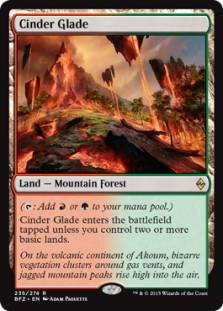 On the subject of role-changing, it's easy to oversell the deck's linearity when it also can threaten a strong control game. With seven basic Mountains, four Cinder Glades, and a Stomping Ground, the Titan pilot can easily lock down the board with recurring Bolt effects off an active Valakut. Instant-speed land search, such as fetches and Expeditions, lets you screw with even the Infects, Twins, and Affinitys of the world (you win a prize every time you snipe Etched Champion). This control role is built into the deck and is more a playstyle decision than a construction one, which means you can leverage it as much or as little as the matchup demands. Of course, sideboard cards like Anger of the Gods let you commit more heavily to a control mode, which gives you even more versatility in Games 2-3.
On the subject of role-changing, it's easy to oversell the deck's linearity when it also can threaten a strong control game. With seven basic Mountains, four Cinder Glades, and a Stomping Ground, the Titan pilot can easily lock down the board with recurring Bolt effects off an active Valakut. Instant-speed land search, such as fetches and Expeditions, lets you screw with even the Infects, Twins, and Affinitys of the world (you win a prize every time you snipe Etched Champion). This control role is built into the deck and is more a playstyle decision than a construction one, which means you can leverage it as much or as little as the matchup demands. Of course, sideboard cards like Anger of the Gods let you commit more heavily to a control mode, which gives you even more versatility in Games 2-3.
Of course, all this begs some questions. First, what makes Titan Scapeshift better than conventional Scapeshift lists? Also, perhaps more pressingly, why play this over other goldfish combos in Modern? This skeptical (but open!) line of inquiry is how we should approach any new deck, and it's how we analyzed Naya Humans a few weeks ago: this method forces us to put aside hype and consider a deck's strengths in context.
The Interaction Trap
Before the Good Ship Modern set sail, I decided I would be playing Scapeshift Combo in the eventual "Overextended"/"Legacy Lite" format. It had been an Extended favorite of mine for years (Ben Stark was my hero), and I was pumped to play it when Modern inevitably roared onto the competitive scene.
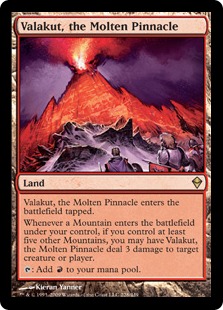 Then Tom LaPille launched the format with one hand and keelhauled my pet deck with the other. Oh well. Guess I could play Twelvepost instead!
Then Tom LaPille launched the format with one hand and keelhauled my pet deck with the other. Oh well. Guess I could play Twelvepost instead!
Although Wizards eventually released Valakut from its wrongful incarceration (and it's for the best we only had a few months to enjoy Cloudpost), it quickly became clear that the old Extended Scapeshift strategies had serious issues in Modern. If you've ever tried to play a fair deck in the format, you've encountered one of these problems. If you've ever tried to play an unfair deck in Modern, you've encountered the other. RG Titan Scapeshift seeks to address both of these traditional Scapeshift shortcomings, which is why the deck is such a great choice today.
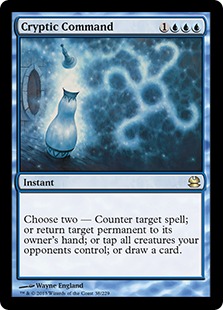 Let's start with the first problem: Modern has so many proactive threats it's almost impossible to reactively answer all of them. This is the longstanding downfall of fair decks and it's plagued Scapeshift since Valakut's 2012 unbanning. When you commit to Temur, you pledge yourself to a familiar set of cards: Snapcaster Mage, Lightning Bolt, Cryptic Command, Remand, etc. This set of cards in particular, and this category of answers more generally, works when you can predict the metagame and when you know the predicted metagame is suited towards your answers. It's much less effective when you bounce between Infect and Affinity in the first few rounds, Amulet Bloom and Burn in the next, and Gruul Zoo and Twin just after that. Add in the Junds, Abzans, and Company decks of the world, and only a quarter of your interaction tends to be live in any given game. You can't run hot with so many dead slots.
Let's start with the first problem: Modern has so many proactive threats it's almost impossible to reactively answer all of them. This is the longstanding downfall of fair decks and it's plagued Scapeshift since Valakut's 2012 unbanning. When you commit to Temur, you pledge yourself to a familiar set of cards: Snapcaster Mage, Lightning Bolt, Cryptic Command, Remand, etc. This set of cards in particular, and this category of answers more generally, works when you can predict the metagame and when you know the predicted metagame is suited towards your answers. It's much less effective when you bounce between Infect and Affinity in the first few rounds, Amulet Bloom and Burn in the next, and Gruul Zoo and Twin just after that. Add in the Junds, Abzans, and Company decks of the world, and only a quarter of your interaction tends to be live in any given game. You can't run hot with so many dead slots.
BGx decks compensate for this deficiency with the best generic answers in Modern. Jund gets Bolt for low-toughness creatures (which Scapeshift shares), and Abrupt Decay, Thoughtseize, and Inquisition of Kozilek for everything else (which Scapeshift notably lacks). When your own best generic answer, Cryptic Command, doesn't come online until turn four, you're in trouble. That's also at play when aggressive decks laugh your Remand out of the match. RG Titan Scapeshift abandons all this interaction in favor of a streamlined, linear approach: as they say, if you can't beat 'em, join 'em. It's no coincidence that traditional Scapeshift lists have lingered in Tier 2 around the 2%-3.5% mark all year. It's also no coincidence that Grixis decks are shifting away from the kind of interaction seen in old Temur lists and towards the better answers (notably Inquisition) of BGx. The Titan lists also pass on this inferior interaction in favor of something more active.
Turn Four or Bust
Speaking of active, this brings us to the second problem Titan Scapeshift seeks to address: the closer your proactive deck can get to (or beyond) the turn four win, the more success you tend to enjoy in Modern. Can you win on turn four with these older Temur lists? Sometimes, but it certainly isn't common and your deck isn't designed to push that win. Turn five is much more common, with turn six 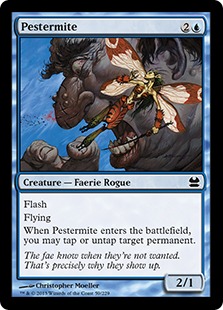 equally possible depending on your draws. Unfortunately, this can make you feel like you're playing a bad Twin. Yes, Scapeshift can compensate for this by being a one-card combo that blanks creature removal. In practice, however, the comparative advantages of this approach is often outweighed by the disadvantage of being 1-2 turns slower than Twin. It doesn't help that Pestermite and friends enable longer reach if the game draws out. Speed is yet another issue, especially when you need to shelve interaction and head off to the races: your fastest pace is still 1-2 turns slower than even the "fairer" fast decks like Ad Nauseam and Zoo.
equally possible depending on your draws. Unfortunately, this can make you feel like you're playing a bad Twin. Yes, Scapeshift can compensate for this by being a one-card combo that blanks creature removal. In practice, however, the comparative advantages of this approach is often outweighed by the disadvantage of being 1-2 turns slower than Twin. It doesn't help that Pestermite and friends enable longer reach if the game draws out. Speed is yet another issue, especially when you need to shelve interaction and head off to the races: your fastest pace is still 1-2 turns slower than even the "fairer" fast decks like Ad Nauseam and Zoo.
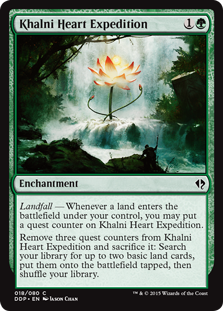 Primeval Titan lists tackle this by maximizing turn four wins and minimizing vulnerabilities. Nguyen described Khalni Heart Expedition as the best card of the deck for good reason: it's by far your fastest way to reach lethal by turn four. Most hands with an Expedition are going to threaten that kill, and even the no-Expedition ones can get there: turn one Search for Tomorrow, turn two Farseek, and turn three Elder/Explore will probably enable the full-force Scapeshift when you untap. Perhaps more importantly, the Expedition approach is virtually immune to the creature removal which so stymies Infect, Burn, Affinity, and even Twin. In addition, you're playing a ramp deck with protection not only from anti-Tron Fulminator Mages, but also the terrifying Blood Moon. Few big-mana strategies can claim that dual resistance.
Primeval Titan lists tackle this by maximizing turn four wins and minimizing vulnerabilities. Nguyen described Khalni Heart Expedition as the best card of the deck for good reason: it's by far your fastest way to reach lethal by turn four. Most hands with an Expedition are going to threaten that kill, and even the no-Expedition ones can get there: turn one Search for Tomorrow, turn two Farseek, and turn three Elder/Explore will probably enable the full-force Scapeshift when you untap. Perhaps more importantly, the Expedition approach is virtually immune to the creature removal which so stymies Infect, Burn, Affinity, and even Twin. In addition, you're playing a ramp deck with protection not only from anti-Tron Fulminator Mages, but also the terrifying Blood Moon. Few big-mana strategies can claim that dual resistance.
This turn four win potential, on top of the deck's relative resilience to interaction, makes Titan Scapeshift a surprisingly strong choice in unknown metagames. Will you get run over on turns two or three by some opponents? Bet on it. Aaron Webster goldfished his way to a Game 1 Affinity win in the Pittsburgh quarterfinals. Nguyen had a similar issue in Round 10 against a ferocious Burn opener by Wing Chun Yam. If you're playing this deck, expect to lose games when you lose coin flips, and expect to lose when your foes get decent hands. That said, will you punish decks when they stumble? Will your Valakuts chisel away as opponents waste interaction? Bet on all that too. Your list has a dangerous degree of inevitability and redundancy, and although it won't be as fast as something like Amulet Bloom, you have fewer moving parts and more copies of the parts you do have. You can also just topdeck Commune with Lava to Sphinx's Revelation yourself into a win. This joint consistency and proactivity give the deck a big edge in the metagame, especially over conventional Scapeshift lists.
Choosing Your Solitaire Deck
To some extent, many of Titan Scapeshift's edges are also shared by other decks. You don't need to look far in Modern to find strong proactive strategies, especially those winning around turn four. We've addressed why you should be playing this particular Scapeshift over other versions of the one-card combo, but what about selecting this deck over other combo decks more generally? Following our earlier points, here are three general principles underlying Titan Scapeshift's viability in any given metagame. Remember that no single one of the three principles would justify using the deck. It's the combination of all three factors driving the deck's relevance.
 Consistency
Consistency
With a playset each of Scapeshift, Titan, and Valakut, on top of the 16+ ramp spells, it's almost impossible to draw a hand that can't win on turn 4-5. Many will lean towards turn four. Other combos will stumble on bad draws and missed land drops. If you trip, it's because you kept a really boneheaded hand or are unluckier than Brian Kibler circa 2012.
- Inevitability
Some decks run out of steam, whether due to limited threats or a dependency on synergy-based win conditions that don't work when topdecked on weak boards. Left to its own devices, Titan Scapeshift will get there in the end. Between the Titan/Scapeshift/Valakut trifecta, not to mention the nasty Commune with Lava, the long game will often go to you.
 Resilience
Resilience
Titan Scapeshift has a rare combination of innately resilient threats, redundant combo pieces, and a win condition that laughs off most hate. Like Amulet Bloom, you can easily win games without playing a single creature, effectively blanking enemy removal and eliminating interaction angles. Like Burn, you have very few individual cards that "matter", so a discarded or countered threat is easily replaced. And unlike some of Modern's premier combos (the previously mentioned Bloom, along with Tron and Affinity), you don't collapse to specific hate cards. Neither Blood Moon nor Fulminator Mage, nemeses of big-mana decks, stop you for long!
- Role-shifting
One of Amulet Bloom's biggest strengths is its ability to trade combo pieces for over-the-top midrange and control elements in certain matchups. This role-switch allows Bloom, a "combo" deck, to enjoy a remarkably neutral (even positive) contest against decks like Jund which should eat combo for breakfast. Titan Scapeshift can do the same, especially depending on how you build your sideboard. Even outside of the board, your Valakuts and 11+ "Mountains" give you ample board-control options whether it's Game 1 or Game 3. Few combo decks boast such a maindeck ability to interact and go linear.
In most cases, you can use these guidelines to pick between decks. Titan Scapeshift vs. Amulet Bloom? Bloom fires on the "consistency", "inevitability", and "role-shifting" cylinders, but crumbles in Blood Moon heavy metagames. That weakness, itself part of the "resilience" department, will determine your choice. What about Ad Nauseam? There's a combo which can match Scapeshift in "consistency" and even "inevitability", but falls flat in "role-shifting". If you want that versatility, especially in a diverse or unknown metagame, this might push you towards Nguyen's and Mispagel's builds. Overall, this kind of comparative method can help you narrow down your choices, as long as you are able to assess other decks for similar strengths and weaknesses.
What's Next for Titan Scapeshift?
Looking to current Tier 2 decks in Modern, Temur Scapeshift still represents the biggest share of the overall Scapeshift showings. The toolbox Bring to Light representatives are close behind, with the upstart Titan lists still gaining ground. Despite Nguyen's and Mispagel's wins, this deck has a long way to go before it can reach those upper echelons. We'll want to see at least a few more datapoints before committing too heavily to this deck or its Modern longevity.
What other experience do you have with the deck? Are there any other considerations you want us to keep in mind when choosing between this Scapeshift and other options? Any improvements you would suggest to the lists? Take it into the comments and I'll see you tomorrow with some exciting test results from one of Modern's most controversial unbanning suggestions...






Interesting article. I’ve bumped into these decks a couple of times of late, and I’ve been witness to both ends of the spectrum (they fold to power hands, but if you durdle, they will value-play you into the dirt). I do find myself wondering if something like Pyroclasm mainboard can help fend off the likes of those fast aggro decks Valakut Titan would otherwise struggle against, though – I’m a bit unconvinced by Commune with Lava’s being maindeck-caliber, as the format is rife with linear aggro decks that are too fast for that card to come into its own, but will fold to (or be severely delayed by) a sweeper. Apart from that… a red deck without Bolts always makes me twitch involuntarily, but I can understand it in this case.
Liked that deck a lot. Nguyen also makes the observation that it wouldn’t be possible without Cinder Glades, those extra 2 damage per land with Stomping Ground are the difference between dying before the kill or not.
Let’s see how Oath manages, Kozilek’s Return is a promising sweeper since it gets around Forge-Tenders and Etched Champions (though jury is up on whatever that’s worth 3 mana). Less aggro means more countermagic and Thoughtseizes, so it could go bad for it.
I think you missed one key fault of the RG build as compared to the normal RUG build–the RG build is far weaker against stack-based interaction (countermagic) than the RUG build. RUG scapeshift can often set up a turn where they have a large mana advantage and just blow through countermagic with remands and cryptics; RG scapeshift is basically at the mercy of a cryptic command deck, should you run into one of them; it’s not a common matchup, but it is a relevant weakness.
True. However, stack-based interaction is on a decline since the meta is really aggro heavy, with lots of Affinity/Burn/Zoo. So, the meta is favorable for this deck now.
If the meta slows down a bit, then regular/Bring to Light Scapeshift becomes a better choice.
If you’re playing against a blue based control deck, that isn’t twin, you don’t even have to resolve scapeshift to win. You just have to ramp a bunch of mountains out, find valakuts either with primeval titan or naturally drawing them, and play lands until they die. I think the biggest problem this deck has is with fast combo and aggro. It runs no interaction mainboard and is just like a turn too slow for most of the fast decks in modern. The current version leans really heavily on its sideboard to shore up it’s bad matchups.